By Kenneth Richard on 10. April 2017
Modern Solar Grand Maximum Ends
‘Little Ice Age’ Cooling On The Way
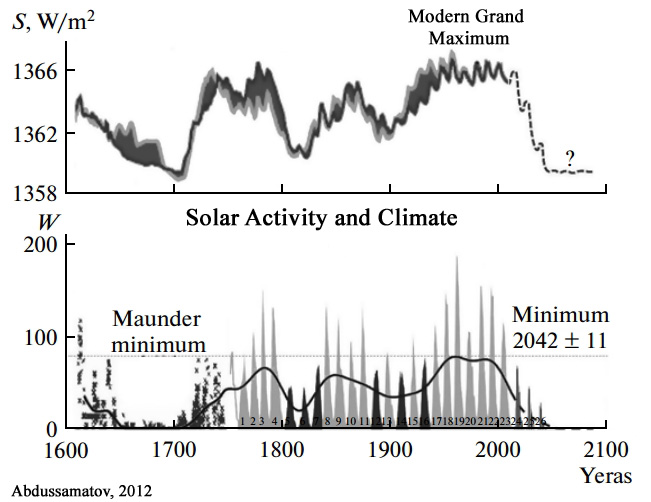
During the 20th and early 21st centuries, Earth’s inhabitants have enjoyed an epoch of very high solar activity that is rare or unique in the context of the last several thousand years. The higher solar activity and warmer temperatures have allowed the planet to briefly emerge from the depths of the successive solar minima periods and “Little Ice Age” cooling that lasted from the 1300s to the early 1900s. Unfortunately, solar scientists have increasingly been forecasting a return to a solar minimum period in the coming decades, as well as the concomitant cooler temperatures.
In several newly published (2017) papers, scientists have suggested that a substantial deterioration into solar minimum conditions and global cooling may be imminent (see, for example, here and here and here). What follows is a collection of dozens of other papers that have also projected a solar minimum-induced “Little Ice Age” climate for the foreseeable future.
The analysis concludes with references to recently published papers that indicate the North Atlantic region has already begun cooling rapidly within the last decade. Scientists have long suggested that what happens in the North Atlantic may have global-scale implications, and thus the observed North Atlantic cooling trend may be a harbinger of the climate that is to come.
The Modern Grand Maximum Of Solar Activity A ‘Rare’ Or ‘Unique’ Event
Usoskin et al., 2014 “[T]he modern Grand maximum (which occurred during solar cycles 19–23, i.e., 1950–2009) was a rare or even unique event, in both magnitude and duration, in the past three millennia. Except for these extreme cases, our reconstruction otherwise reveals that solar activity is well confined within a relatively narrow range.”
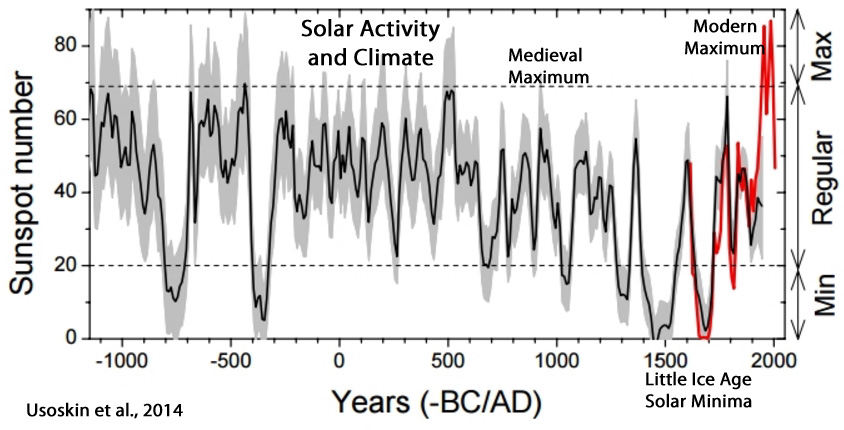
Lockwood et al., 2009 “[T]he Sun has been unusually active over recent decades (Solanki et al. 2004; Vonmoos et al. 2006; Muscheler et al. 2007; Steinhilber et al. 2008). Solanki et al. (2004) used the 14C isotope abundance found in tree trunks and concluded that the Sun has been more active recently than at any time in the previous 8000 years and that it was as active as in recent decades for only 10% of the past 11000 years.”
Chen et al., 2015 “We explored the sources and characteristics of each pigment, reconstructed an 800-year record of ultraviolet radiation (UVR) and total incoming light intensity, and identified the possible factors that may have influenced historical UVR changes in this region. The results indicated at least four UVR [ultraviolet radiation] peaks during the past 800 years, corresponding to c. AD 1950–2000, 1720–1790, 1560–1630 and 1350–1480, with the intensity from the most recent [1950-2000] sediments being the highest.”
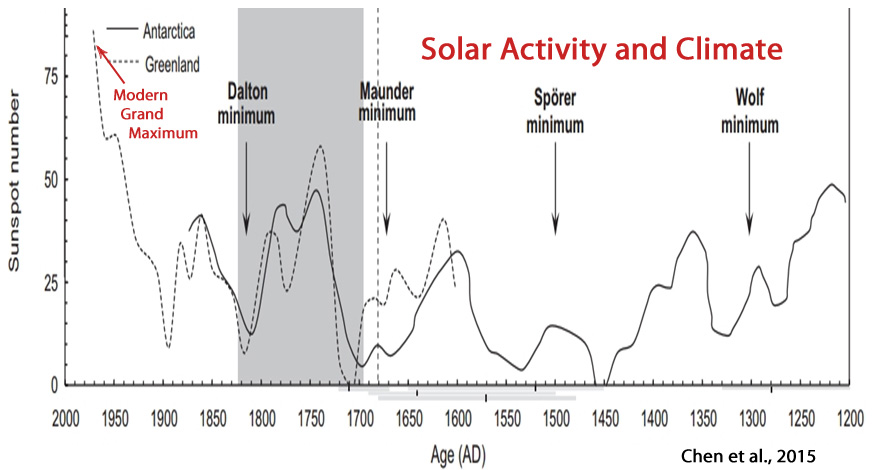
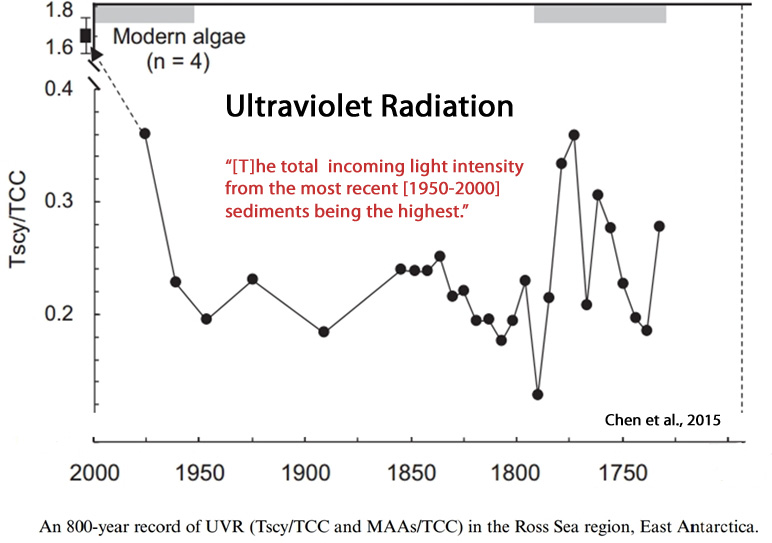
The Modern Grand Maximum Of Solar Activity Has Recently Drawn To A Close
Wang et al., 2010 “It is seen that a very active period that began in 1920, the so-called ‘current grand solar maximum’, will probably end during 2011-2027, since a variety of indices related to solar activity have significantly shifted since 1987. … [T]he current grand solar maximum has already lasted for eight 11-year solar cycles and might end in the coming one/two 11-year cycles; a grand solar minimum might prevail in the next 100–200 years.”
Zharkova et al., 2015 “The longest direct ervation of solar activity is the 400-year sunspot-number series, which depicts a dramatic contrast between the almost spotless Maunder and Dalton minima, and the period of very high activity in the most recent 5 cycles [1950s – 2000s], prior to cycle 24. … The records show that solar activity in the current cycle 24 is much lower than in the previous three cycles 21–23 revealing more than a two-year minimum period between cycles 23 and 24. This reduced activity in cycle 24 was very surprising because the previous five cycles were extremely active and sunspot productive forming the Modern Maximum.”
“We predict correctly many features from the past, such as: 1) an increase in solar activity during the Medieval Warm period; 2) a clear decrease in the activity during the Little Ice Age, the Maunder Minimum and the Dalton Minimum; 3) an increase in solar activity during a modern maximum in 20th century. .. We note, in particular, a decreasing activity for solar cycles 25 and 26 coinciding with the end of the previous 350–400-year grand cycle and then increase of the solar activity again from cycle 27 onwards as the start of a new grand cycle with an unusually weak cycle 30. Hence, cycles 25–27 marks a clear end of the modern grand period that can have significant implications for many aspects of solar activity in human lives including the current debate on climate change.”
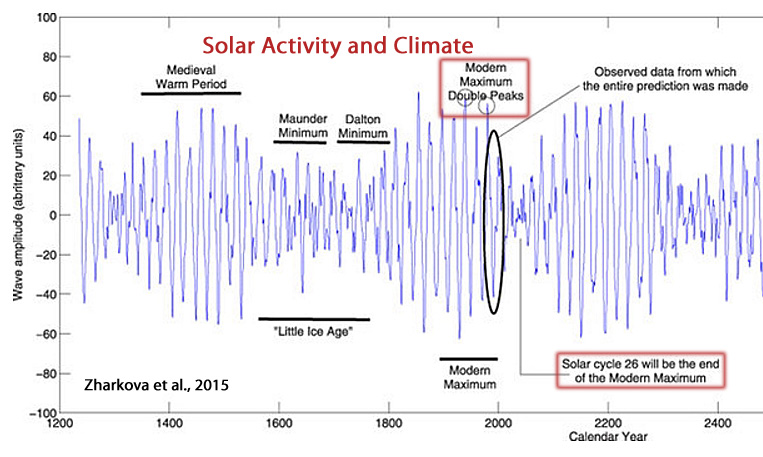
press release A new model of the Sun’s solar cycle is producing unprecedentedly accurate predictions of irregularities within the Sun’s 11-year heartbeat. The model draws on dynamo effects in two layers of the Sun, one close to the surface and one deep within its convection zone. Predictions from the model suggest that solar activity will fall by 60 per cent during the 2030s to conditions last seen during the ‘mini ice age’ that began in 1645. … Results will be presented today by Prof Valentina Zharkova at the National Astronomy Meeting in Llandudno. … Zharkova and her colleagues derived their model using a technique called ‘principal component analysis’ of the magnetic field observations from the Wilcox Solar Observatory in California. They examined three solar cycles-worth of magnetic field activity, covering the period from 1976-2008. In addition, they compared their predictions to average sunspot numbers, another strong marker of solar activity. All the predictions and observations were closely matched. “Combining both waves together and comparing to real data for the current solar cycle, we found that our predictions showed an accuracy of 97%,” said Zharkova. “Effectively, when the waves are approximately in phase, they can show strong interaction, or resonance, and we have strong solar activity. When they are out of phase, we have solar minimums. When there is full phase separation, we have the conditions last seen during the Maunder minimum, 370 years ago.”
‘All Proponents Of Planetary Forcing Have Forecasted A Solar Grand Minimum For The Upcoming Decades’
Sánchez-Sesma, 2015 “Solar activity (SA) has non-linear characteristics that influence multiple scales in solar processes (Vlahos and Georgoulis, 2004). For instance, millennia-scale solar oscillations have been recently detected, like those of about 6000 and 2400 years, by Xapsos and Burke (2009) and Charvátová (2000), respectively, with important and interesting influences in the near past and future climate. These millennial-scale patterns of reconstructed solar activity variability could justify epochs of low activity, such as the Maunder Minimum, as well as epochs of enhanced activity, such as the current Modern Maximum, and the Medieval Maximum in the 12th century. Although the reason for these solar activity oscillations is unclear, it has been proposed that they are due to chaotic behavior of non-linear dynamo equations (Ruzmaikin, 1983), or stochastic instabilities forcing the solar dynamo, leading to on-off intermittency (Schmittet al., 1996), or planetary gravitational forcing with recurrent multi-decadal, multi-centennial and longer patterns (Fairbridge and Sanders, 1987; Fairbridge and Shirley,1987; Charvátová, 2000; Duhau and Jager, 2010; Perry and Hsu, 2000). It should be noted that all proponents of planetary forcing have forecasted a solar Grand Minimum for the upcoming decades, but one of them has also forecasted a Super Minimum for the next centuries (Perry and Hsu, 2000). In addition, during recent decades, statistical forecasts (with physically-based spectral information of reconstructed records) of solar magnetic activity predict a clear decrease in solar activity, reaching a minimum around AD 2100 (Steinhilber et al., 2013; S13, hereafter, Velasco et al., 2015)”
Liu et al., 2011 “Climate events worldwide, such as the MWP and LIA, were seen in a 2485-year temperature series. The largest amplitude and rate of temperature both occurred during the EJE [Eastern Jin Event (343–425 AD)], but not in the late 20th century. The millennium-scale cycle of solar activity determined the long-term temperature variation trends, while century-scale cycles controlled the amplitudes of temperature. Sunspot minimum events were associated with cold periods. The prediction results obtained using caterpillar-SSA showed that the temperature would increase until 2006 AD on the central-eastern Plateau, and then decrease until 2068 AD, and then increase again.”
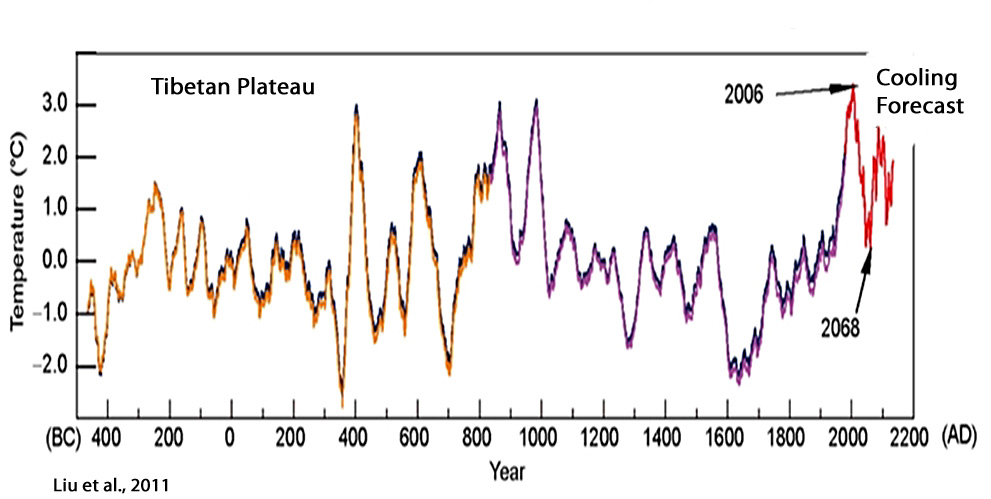
Steinhilber and Beer, 2013 “Our methods are able to predict periods of high and low solar activities for a few centuries in the past. However, they are less successful in predicting the correct amplitude. Then, the methods were used to predict the period 2000–2500. Both methods predict a period of low activity around 2100 A.D. Between 2100 and 2350 A.D., the results are inconsistent regarding the duration of the low-activity state in 2100 A.D. and the level of activity until 2250 A.D.”

Lüdecke et al., 2015 “The Earth’s climate shows a rather regular oscillation of ∼ 200 year period during the last millennia. However, frequency, phase, and strength of the oscillation are found to vary in different time series of temperatures and for different times (see Figs. 4–6, and 5 8). Nonetheless, the relative historic stability of the cycle suggests that the periodic nature of the climate will persist also for the foreseeable future. Disregarding other conceivable forcings e.g. anthropogenic influences, an approximate prediction of the climate for the next 100 years suggests itself. Figure 9 shows the Tsine representation from AD 1800 to AD 2100 derived from the ∆Tsine representation by a π/2 phase shift. It gives correctly the 1850–1900 temperature minimum and shows a temperature drop from present to ∼ AD 2080, the latter comparable with the minimum of 1870, as already predicted in the studies (Steinhilber and Beer, 2013; Liu et al., 2011) on the grounds of solar activity data alone.”
Herrera et al., 2015 “Of particular interest now is the fact that the behavior of the solar cycle 23 minimum has shown an activity decline not previously seen in past cycles for which spatial observations exist: this could be signaling the start of a new grand solar minimum.”
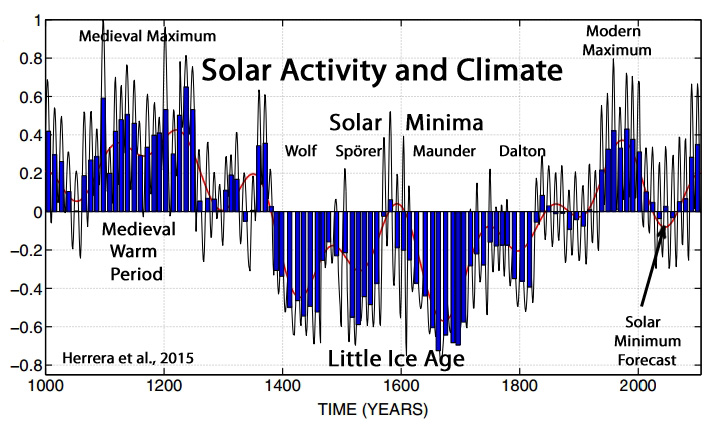
Evans, 2016 “Four manifestations of unconventional climate influences are identified, each with at least as much effect on surface temperature as the direct heating effect of changes in total solar irradiance (TSI): external-driven albedo; countervailing cooling during TSI peaks, implied by the absence of corresponding peaks in the surface temperature record (the “notch”); the long-term sensitivity of surface warming to TSI increases; and the delay of ∼11 years between changes in underlying or smoothed TSI and the corresponding changes in surface temperature. We hypothesize these are all manifestations of a single force whose exact mechanism is unknown but whose crucial properties can be deduced: “Force X” modulates the Earth’s albedo, and lags TSI by one sunspot cycle or half the ∼22-year cycle of the Sun’s hydromagnetic dynamo. A second, alternative hypothesis is of “force N” for the notch and “force D” for the delayed force causing the other three manifestations. The notch-delay solar model can explain the global warming of the last few decades and centuries in terms of force X/D. Several solar indicators including TSI peaked ∼1986, but surface warming continued until ∼1998, which is explained by the delay. The notch-delay hypothesis predicts sustained and significant global cooling starting sometime in the period 2017 to 2022, of ∼0.3°C but perhaps milder (TSI estimates vary), as force X/D falls off in response to the marked decline in underlying TSI from around 2004—one of the three biggest and fastest falls in TSI since sunspot records began in 1610.”
Abdussamatov, 2015 “A long-term negative deviation of the Earth’s average annual energy balance from the equilibrium state is dictating corresponding variations in it’s the energy state. As a result, the Earth will have a negative average annual energy balance also in the future. This will lead to the beginning of the decreasing in the Earth’s temperature and of the epoch of the Little Ice Age after the maximum phase of the 24-th solar cycle approximately since the end of 2014. The influence of the consecutive chain of the secondary feedback effects (the increase in the Bond albedo and the decrease in the concentration of greenhouse gases in the atmosphere due to cooling) will lead to an additional reduction of the absorbed solar energy and reduce the greenhouse effect. The start of the TSI’s Grand Minimum is anticipated in the solar cycle 27±1 in 2043±11 and the beginning of the phase of deep cooling of the 19th Little Ice Age for the past 7,500 years around 2060±11. … Thus, the long term variations of the solar constant (allowing for their direct and secondary impacts, with the latter being due to feedback effects) are the major and essential cause of climate changes because the Earth’s climate variation is a function of longterm imbalance between the solar radiation energy incoming into the upper layers of the Earth’s atmosphere and Earth’s total energy outgoing back to space.”
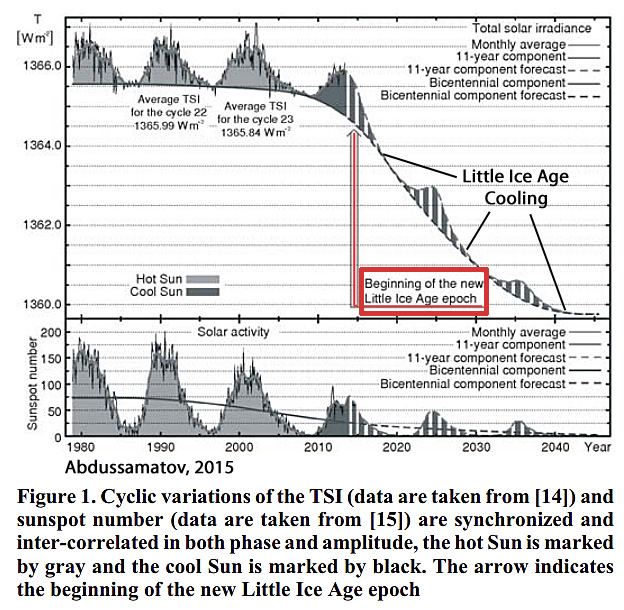
Yndestad and Solheim, 2016 “In 1890´s G. Spörer and E. W. Maunder (1890) reported that the solar activity stopped in a period of 70 years from 1645 to 1715. Later a reconstruction of the solar activity confirms the grand minima Maunder (1640-1720), Spörer (1390-1550), Wolf (1270-1340), and the minima Oort (1010-1070) and Dalton (1785-1810) since the year 1000 A.D. (Usoskin et al. 2007). These minimum periods have been associated with less irradiation from the Sun and cold climate periods on Earth. An identification of a three grand Maunder type periods and two Dalton type periods in a period thousand years, indicates that sooner or later there will be a colder climate on Earth from a new Maunder- or Dalton- type period. …. The result shows that the TSI variability and the sunspots variability have deterministic oscillations, controlled by the large planets Jupiter, Uranus and Neptune, as the first cause. A deterministic model of TSI [total solar irradiance] variability and sunspot variability confirms the known minimum and grand minimum periods since 1000. From this deterministic model we may expect a new Maunder type sunspot minimum period from about 2018 to 2055. The deterministic model of a TSI ACRIM data series from 1700 computes a new Maunder type grand minimum period from 2015 to 2071. A model of the longer TSI ACRIM data series from 1000 computes a new Dalton to Maunder type minimum irradiation period from 2047 to 2068.”
Torres and Guzmán, 2016 “Conclusions Based on our results, we propose the use of the Wolf’s Number Oscillation Index (WNOI) – as a more uniform alternative to the ONI – in the range over 30 and below -30. The analysis of the material presented and the arguments discussed allows us to define a possible relationship between phenomena related to Solar Cycle, the ENSO, climatic conditions, as well as some criteria for the establishment of public policies for preservation and remediation of the environment in the long run. We can conclude that solar activity oscillations impact the earth climatic conditions to such a extent that they become measurable only in the long run. The magnitude of the Solar Cycle – from 7 to 17 and a mean of 11.2 years – seems to support this statement. Based on the similarities of the Solar Cycles 5 and 24 we can expect a longer period of cold weather for the years 2022 y/o 2034, corresponding to the Solar Cycles 24 and 25.”
Sanchez-Sesma, 2016 “This empirical modeling of solar recurrent patterns has also provided a consequent multi-millennial-scale experimental forecast, suggesting a solar decreasing trend toward grand (super) minimum conditions for the upcoming period, AD 2050–2250 (AD 3750–4450). … Solar activity (SA) has non-linear characteristics that influence multiple scales in solar processes (Vlahos and Georgoulis, 2004). For instance, millennia-scale solar oscillations have been recently detected, like those of about 6000 and 2400 years, by Xapsos and Burke (2009) and Charvátová (2000), respectively, with important and interesting influences in the near, past and future climate. These millennialscale patterns of reconstructed SA variability could justify epochs of low activity, such as the Maunder minimum, as well as epochs of enhanced activity, such as the current Modern Maximum, and the Medieval maximum in the 12th century. … We can conclude that the evidence provided is sufficient to justify a complete updating and reviewing of present climate models to better consider these detected natural recurrences and lags in solar processes.”
Riley et al., 2015 “[W]e suggest that the Sun evolved from a 2008/2009-like configuration at the start of the Maunder Minimum toward an ephemeral-only configuration by the end of it, supporting a prediction that we may be on the cusp of a new grand solar minimum.”
Abdusamatov, 2012 “The Earth as a planet will have a negative balance in the energy budget in the future as well, because the Sun is entering the decline phase of the bicentennial luminosity changes. … A deep bicentennial minimum in solar constant is to be anticipated in 2042 ± 11 and the 19th Little Ice Age (for the last 7500 years) may occur in 2055 ± 11.”

Solheim et al., 2012 “No significant trend is found between the length of a cycle and the average temperature in the same cycle, but a significant negative trend is found between the length of a cycle and the temperature in the next cycle. This provides a tool to predict an average temperature decrease of at least 1°C from solar cycle 23 to solar cycle 24 for the stations and areas analyzed. We find for the Norwegian local stations investigated that 25–56% of the temperature increase the last 150 years may be attributed to the Sun. For 3 North Atlantic stations we get 63–72% solar contribution. This points to the Atlantic currents as reinforcing a solar signal.”
Roth and Joos, 2013 “In contrast to earlier studies, periods of high solar activity were quite common not only in recent millennia, but throughout the Holocene. Notable deviations compared to earlier reconstructions are also found on decadal to centennial timescales. We show that earlier Holocene reconstructions, not accounting for the interhemispheric gradients in radiocarbon, are biased low. Solar activity is during 28% of the time higher than the modern average (650 MeV), but the absolute values remain weakly constrained due to uncertainties in the normalisation of the solar modulation to instrumental data. A recently published solar activity–TSI relationship yields small changes in Holocene TSI of the order of 1 W m−2 with a Maunder Minimum irradiance reduction of 0.85 ± 0.16 W m−2. Related solar-induced variations in global mean surface air temperature are simulated to be within 0.1 K. Autoregressive modelling suggests a declining trend of solar activity in the 21st century towards average Holocene conditions.”
Ahluwalia, 2014 “The Sun has emerged from a grand maximum for SSN cycles; it includes cycle 19, the most active cycle ever observed in 400 y. The grand minima are associated with cooler Earth temperatures (Eddy, 1976, 1981). The trend line indicates that we have entered a period of low solar activity; Ahluwalia and Jackiewicz (2012) suggest that we are at the advent of a Dalton-like minimum. The Earth was cooler then, made worse by Mt Tambora volcanic eruption on 5 April 1815.”
Salvador, 2013 “Using many features of Ian Wilson’s Tidal Torque theory, a mathematical model of the sunspot cycle has been created that reproduces changing sunspot cycle lengths and has an 85% correlation with the sunspot numbers from 1749 to 2013. The model makes a reasonable representation of the sunspot cycle for the past 1000 yr, placing all the solar minimums in their right time periods. The forecast is for a solar minimum and quiet Sun for the next 30 to 100 yr.”
Mörner, 2015 “By about 2030-2040, the Sun will experience a new grand solar minimum. This is evident from multiple studies of quite different characteristics: the phasing of sunspot cycles, the cyclic observations of North Atlantic behaviour over the past millennium, the cyclic pattern of cosmogenic radionuclides in natural terrestrial archives, the motions of the Sun with respect to the centre of mass, the planetary spin-orbit coupling, the planetary conjunction history and the general planetary-solar-terrestrial interaction. During the previous grand solar minima—i.e. the Spörer Minimum (ca 1440-1460), the Maunder Minimum (ca 1687-1703) and the Dalton Minimum (ca 1809- 1821)—the climatic conditions deteriorated into Little Ice Age periods.”
Duhau and de Jager, 2010 “[S]olar variability is presently entering into a long Grand Minimum, this being an episode of very low solar activity, not shorter than a century. A consequence is an improvement of our earlier forecast of the strength at maximum of the present Schwabe cycle (#24). The maximum will be late (2013.5), with a sunspot number as low as 55. … Solar activity is believed to be associated with climate change (De Jager and Duhau, 2009; De Jager et al., 2010; Miyahara et al., 2010). Sunspot activity can be concentrated in the two solar hemispheres and they appear to fluctuate for 11 year cycles. However, prolonged episodes of reduced sunspot activity, such as the Maunder Minimum, were clearly linked with an episode of extreme cooling and bitingly cold winters in Europe and North America, known as the ‘little ice age‘.”
Russell et al., 2010 “If we were to guess what the next solar cycle was going to be like from the behavior of the declining phase of solar cycle 23 to date, we would select solar cycle 4 beginning in 1785 as the analog of solar cycle 23 and solar cycles 5 and 6 as the analogs of the upcoming cycles 24 and 25. At this writing, the similarity of the inability of the new cycle to take hold with significant new cycle activity at high latitudes is striking. The epoch of cycles 5 and 6 has also been called the Dalton minimum, during which the sunspot number maximized at close to 50. It was also a period of global cooling.”
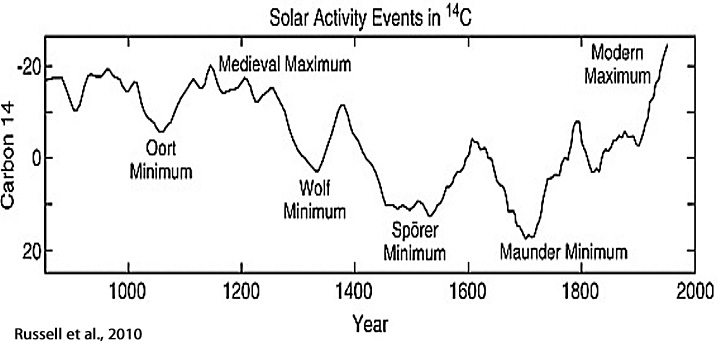
Miyahara et al., 2010 “Specifically, the “Little Ice Age” covers a cyclic period of cooling and glaciation which began in the 13th century and which continued into the 16th to 19th centuries, when glaciers began advancing southwards in Greenland and the North Atlantic, and perhaps worldwide. These episodes of global cooling appear to be linked to reduced solar activity. By contrast, the Medieval Warm Period occurred during a period of heightened solar activity. If these associations are valid, then future cyclic alterations would be expected to impact global temperatures including perhaps triggering another period of global cooling if sunspot activity is again reduced to a minimum. … The Sun is currently showing slightly different behavior compared with recent decades (Livingston & Penn, 2009). Consequently, concern has emerged regarding whether the Sun is approaching the next Maunder Minimum of reduced activity. Given this scenario, it has been suggested that global temperatures may decrease by about 0.3 °C as a result of a reduction in total solar irradiance (Feulner & Rahmstorf, 2010).”
Scafetta, 2012 “The model forecasts a new prolonged solar grand minimum during 2020-2045, which would be produced by the minima of both the 61 and 115-year reconstructed cycles. Finally, the model predicts that during low solar activity periods, the solar cycle length tends to be longer, as some researchers have claimed. These results clearly indicate that solar and climate oscillations are linked to planetary motion and, furthermore, their timing can be reasonably hindcast and forecast for decades, centuries and millennia.”
Archibald, 2007 “Our forecast for global average temperature to 2030 has been updated for the progression of Solar Cycle 23 and the contribution that will be made by increased carbon dioxide in the atmosphere. The increased length of Solar Cycle 23 supports the view that Solar Cycle 24 will be weak, with the consequence of increased certainty that that there will be a global average temperature decline in the range of 1° to 2° C for the forecast period [by 2030]. The projected increase of 40 ppm in atmospheric carbon dioxide to 2030 is calculated to contribute a global atmospheric temperature increase of 0.04°C. The anthropogenic contribution to climate change over the forecast period will be insignificant relative to natural cyclic variation.”
Landschiedt, 2003 “Analysis of the sun’s varying activity in the last two millennia indicates that contrary to the IPCC’s speculation about man-made global warming as high as 5.8° C within the next hundred years, a long period of cool climate with its coldest phase around 2030 is to be expected. It is shown that minima in the 80 to 90-year Gleissberg cycle of solar activity, coinciding with periods of cool climate on Earth, are consistently linked to an 83-year cycle in the change of the rotary force driving the sun’s oscillatory motion about the centre of mass of the solar system. As the future course of this cycle and its amplitudes can be computed, it can be seen that the Gleissberg minimum around 2030 and another one around 2200 will be of the Maunder minimum type accompanied by severe cooling on Earth. This forecast should prove skillful as other long-range forecasts of climate phenomena, based on cycles in the sun’s orbital motion, have turned out correct as for instance the prediction of the last three El Niños years before the respective event.”
The North Atlantic Region – Linked To Global Climate – Has Already Been Cooling Rapidly
Chafik et al., 2016 “The multidecadal variability of the North Atlantic Ocean has a strong signal in the sea surface temperature with many global climate linkages [Enfield et al., 2001; Knight et al., 2006]. An even stronger multidecadal signal can be found in the subpolar temperatures and salinities, where the Atlantic Water inflow variations constitute an essential part in the variability [Hátún et al., 2005; Häkkinen et al., 2011a; Reverdin, 2010]. The atmospheric forcing in the subpolar North Atlantic Ocean is dominated by the variability of the North Atlantic Oscillation (NAO), i.e., the leading mode of atmospheric variability in the North Atlantic sector, which modulates the atmosphere-ocean momentum and heat exchanges on a range of temporal scales. The subpolar ocean variability thus appears to be tightly connected to atmospheric forcing and associated basin-scale circulation changes, which together force the subpolar ocean properties toward extremes [Lozier et al., 2008, 2010], either to warm-saline or cold-fresh conditions on multidecadal scales. These regime changes [in the North Atlantic] have recently been argued to be important for global mean surface temperature warming acceleration and hiatus [Chen and Tung, 2014; Drijfhout et al., 2014].”
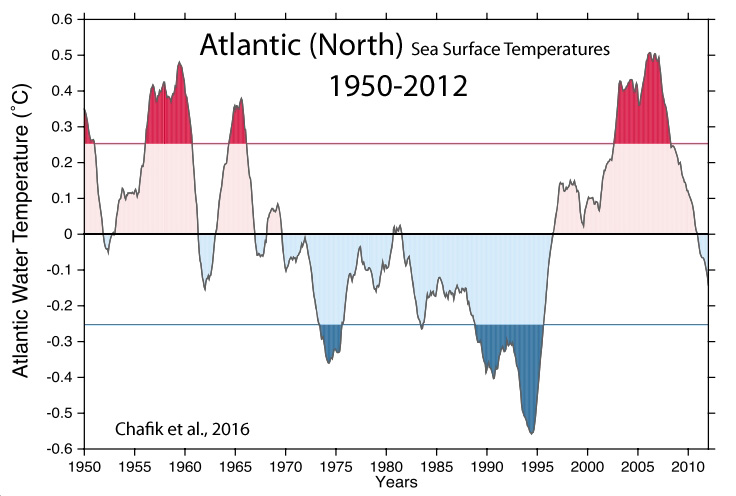
Duchez et al., 2016 “[C]old ocean temperatures were the most extreme in the modern record [since 1948] over much of the mid-high latitude North-East Atlantic. … we consider the exceptionally cold ocean surface anomaly that was already in place prior to the onset of the 2015 heat wave. The SST anomaly field for June 2015 shows temperatures up to 2 °C colder than normal over much of the sub-polar gyre with values that are the coldest observed for this month of the year in the period 1948–2015 indicated by stippling. The cause of this cold anomaly has been the subject of widespread interest in the media, we now show for the first time that it can be attributed to a combination of air–sea heat loss from late 2014 through to spring 2015 and a re-emergent sub-surface ocean heat content [cold] anomaly that developed in preceding years.”
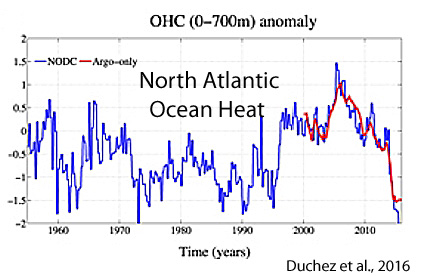
Robson et al., 2016 “In the mid-1990s the North Atlantic subpolar gyre warmed rapidly, which had important climate impacts such as increased hurricane numbers and changes to rainfall over Africa, Europe and North America. Evidence suggests that the warming was largely due to a strengthening of the ocean circulation, particularly the Atlantic Meridional Overturning Circulation. Since the mid-1990s direct and indirect measurements have suggested a decline in the strength of the ocean circulation, which is expected to lead to a reduction in northward heat transport. Here we show that since 2005 a large volume of the upper North Atlantic Ocean has cooled significantly by approximately 0.45 °C or 1.5 × 1022 J, reversing the previous warming trend.”
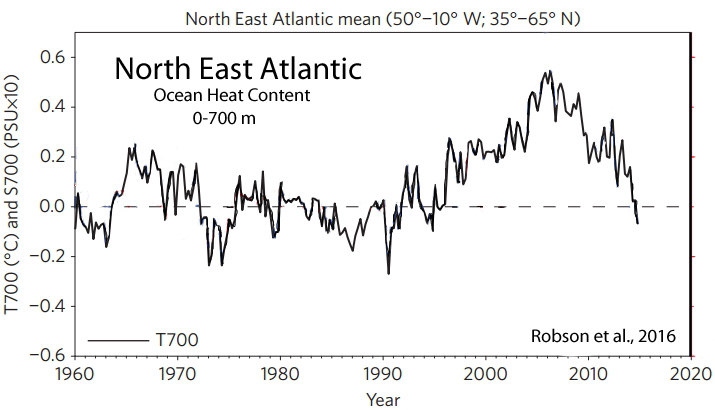
Posted in Cooling/Temperature, Solar, Solar Sciences |



















Very worrying, far more worrying than any warming.
https://www.sciencedaily.com/releases/2015/05/150520193831.htm
Cold weather kills 20 times as many people as hot weather, according to an international study analyzing over 74 million deaths in 384 locations across 13 countries.
—
http://link.springer.com/article/10.1134%2FS0016793213080227
It is shown that, over the past ∼10000 years (the Holocene), deep Maunder type solar minima have been accompanied by sharp climate changes. It has been established experimentally that, at ca 4.0 ka BP, there occurred a global change in the structure of atmospheric circulation, which coincided in time with the discharge of glacial masses from Greenland to North Atlantic and a solar activity minimum. The climate changes that took place at ca 4.0 ka BP [4,000 years before present] and the deep solar activity minimum that occurred at ca 2.5 ka BP [2,500 years before present] affected the development of human society, leading to the degradation and destruction of a number of ancient civilizations.
—
http://www.sciencedirect.com/science/article/pii/S1040618211006707
The Tavoliere salt-marsh appears to have contracted during the arid/warm phases associated to maxima of solar activity and to have expanded during the wet/cold phases of solar minima. This coastal area, characterized by a very flat topography and arid climate, appears to have been very sensitive to even minor hydrological and climate changes. Changes of solar activity, determining extensive environmental transformations, were also possibly responsible for the abandonment of the human coastal settlements of one of the most important Neolithic archaeological districts of Italy.
—
http://www.academia.edu/1411970/The_Influence_of_Climatic_Change_on_the_Late_Bronze_Age_Collapse_and_the_Greek_Dark_Ages
Mediterranean Sea surface temperatures cooled rapidly during the Late Bronze Age, limiting freshwater flux into the atmosphere and thus reducing precipitation over land. These climatic changes could have affected Palatial centers that were dependent upon high levels of agricultural productivity. Declines in agricultural production would have made higher-density populations in Palatial centers unsustainable. The Greek Dark Ages that followed occurred during prolonged arid conditions that lasted until the Roman Warm Period.
—
http://onlinelibrary.wiley.com/doi/10.1111/j.1365-2486.2007.01498.x/abstract
The projected increase of atmospheric CO2 concentration ([CO2]) is expected to increase rice yield, but little is known of the effects of [CO2] at low temperature, which is the major constraint to growing rice in cool climates. The results suggest that yield gain due to elevated [CO2] can be reduced by low temperature.
Cooler countries in the NH will start to feel this first.
Another big worry is the parlous state of many electricity supply systems.
The anti-CO2 agenda has left many of them balanced on a knife-edge.
Wind and solar do not operate well at low temperatures, often consuming more electricity for anti-icing than they actually produce.
Hmm … wasn’t this supposed to be a blog against climate alarmism? Now the skeptics are worried about cooling …
REALISTS have always been far more worried about cooling that a tiny solar forced amount of warming.
As you have amply proven.. CO2 has no part to play in the equation
You have shown that there is zero proof that CO2 causes warming of the oceans, and
zero proof that CO2 causes warming of a convective atmosphere.
Let’s all just hope that there is a little bit more warming to come, because cooling and a resulting drop in CO2 would cause food and energy problems around the world.
Not that you care.
The difference between your alarmism and our realism is that you believe that humans are the dominant cause of weather and climate changes, whereas we understand that natural factors predominantly determine warming or cooling trends. So your alarmism is about “Oh no, we’re making the Earth spin faster and causing glaciers to melt at a catastrophic pace relative to the year 1979!”, whereas ours is “How much longer do we have before Northern Europe, North America, Russia…are once again buried in a kilometer of ice?”
Scientists were seriously worried about the end of the interglacial in the 1970s…because they all know that cooling is MUCH worse than warming. Probably no scientist thinks we’ll be just fine once the Earth plummets into the next glacial. And the next glacial could indeed be imminent. After all, interglacials typically last 10,000 years on average…and we’re in year 11,700 of the Holocene. Once we do enter into the next glacial, it’s 90,000 years of ice sheets.
Excellent collation of relevant papers.
[…] from NoTricksZone By Kenneth Richard on 10. April […]
Just a hypothesis – This next solar minimum may very well drag us into the next major glacial period. Data shows the current, annual, mean insolation at 80 degrees N is around the same level it was towards the end of the last major glaciation, around 18,000 – 20,000 years ago: https://i1.wp.com/ars.els-cdn.com/content/image/1-s2.0-S0277379113004162-gr4.jpg This, combined with low solar, could very well trigger the next glacial period – and there’ll be no turning back this time – the ‘Little ice age’ a few centuries ago was a false start to the ‘Big ice age’. Just something to think about…
A countering factor to all this is the rising water vapor. NASA/RSS has been measuring WV by satellite and reporting it since about 1979 as total precipitable water (TPA). I graphed their data and extrapolated it in Fig 3 of http://globalclimatedrivers2.blogspot.com It has increased about 8% since 1960 and is still increasing (through Feb 2017) at about 1.5%/decade. This increase is about three times expected from just temperature rise.
Once declining solar activity and declining ocean cycles prevail, expect a rapid global temperature down trend slowed only by the huge effective thermal capacitance of the oceans.
Dan – More water vapour = more snowfall to feed glaciers.
Thank-you Kenneth for this compilation of papers. Now come to the true meat of the subject of climate.
Solar events ARE the driver of climate change. Atmospheric CO2 level change is just a symptomatic adjustment nature makes after the effect solar changes penetrate through all the various natural processes. Man’s influence on CO2 level negligible given the natural response to the solar events are so large.
AndyG55 – I agree, but who / what is really behind the anti-CO2 agenda, and do ‘they’ have a plan to deal with a potentially serious cooling period (other than to watch the developed world suffer the consequences of ‘their’ destruction of our energy security? Or are they just a bunch of Nihilists?
Have you looked at how warm the oceans are today? We have just backed off the el nino, yet here comes another, PERHAPS IN PART BECAUSE OF LOW SOLAR! I am a big MOC believer, and that the state of the oceans today is not because of co2, but because of centuries of back and forth that is natural to the system. But what I question in all of this, is the ignoring of the fact that IF YOU ARE PLAYING THE SOLAR CARD, the run up to the LIA was 200 years of Maunder minimum which if you are so tuned into the sun, had to mean the oceans were COLD when the Dalton min came along.
The oceans are very very very slow to change in the large sense. So we have the exact opposite going on now, very warm oceans and I think in large part to the last 200 years of the modern maximum. Throw in the chaos that evolves out of reaction to all this, and you get a system that is very warm but has the sun as the author. Now what happens when you decrease radiation over the tropical Pacific? the easterlies slow.. That in turn leads to build up of warmer water in the enso regions, which in turn leads to the release of water vapor into the atmosphere which is the number 1 GHG. While the increase over the temperature regions is relatively small compared to normal.. that increase is much greater relative to average in the arctic regions ( In other words, the effect on a few grams per kilogram of Water vapor over the tropics may not have that huge and effect on the temperature, but it does in the arctic when it works its way in there, and primarily during its winter) You are watching that in front of your very eyes. So what happens if we keep seeing el ninos until the imbalance caused by 200 years of high activity is finally washed out?
Iam just asking people to understand that the set up for all this is vastly different from what set up the last LIA Regional ups and downs in SST are to be expected. A few short years ago, the NE pac was boiling, but its cold now, but already reversing again! I would not just look at the north atlantic. In fact one of the best arguments you have is the INDIAN OCEAN! for cooling in the tropical oceans far far far outweighs what goes on the further north you get. The reaction process is bang for the buck, and the tropical oceans are the place to watch. A flip in the Indian ocean, Pacific and Atlantic in the cycles, would lead to cooling, though not to the extent of what we saw in the 1800s but perhaps back to the 1970s, which I think is more realistic. either way its not co2 causing this, but nature doing what nature does. Peace to all
—
https://notrickszone.com/wp-content/uploads/2017/03/Holocene-Cooling-Pacific-Ocean-Heat-Content-Rosenthal-13.jpg
—
Can you explain how we have “very warm oceans” now when considering reconstructions that show oceans are only slightly warmer now than they were during the Little Ice Age, and much colder than during the Medieval Warm Period (and Holocene Thermal Maximum)? The entire case you present is predicated on the idea that we have “very warm oceans”. Relative to when? The coldest hundred-year periods of the Holocene? And how do we even know that the reconstructions are right? We don’t. So we have no idea if we have “very warm oceans” or not. Considering all the other proxy evidence, though, it’s likely the oceans are currently NOT “very warm” relative to the last 10,000 years.
Like the North Atlantic, it doesn’t look like the Indian Ocean has been doing more than oscillating since the 1930s:
https://notrickszone.com/wp-content/uploads/2016/12/Holocene-Cooling-Indian-Ocean-SSTs-Zinke-16.jpg
—
On the other hand, below 2000 m….
—
https://notrickszone.com/wp-content/uploads/2016/09/Holocene-Cooling-Pacific-Atlantic-Indian-Oceans-WunschHeimbach14-copy.jpg
—
Wunsch and Heimbach, 2014 (Pacific, Atlantic, Indian Oceans)
“A very weak long-term [1993-2011] cooling is seen over the bulk of the rest of the ocean below that depth [2000 m], including the entirety of the Pacific and Indian Oceans, along with the eastern Atlantic basin.”
I asked my students which would be worse.
Total 6 degrees of CAGW warming, with humans having to mitigate their lives over some 100 plus years.
Or having 1km of ice covering everything north of Iowa, for about 15,000 years.
Their response was the ice ages are over, done, finito. Hence, was not a worry. Wow..
The last interglacial (Eemian, ~125,000 years ago) was several degrees C warmer than the Holocene (11,700 – present) has been. The Arctic regions were up to 8 to 10 degrees C warmer than now. And yet we still plunged into a ~90,000-year-long glacial period after that brief excursion of warmth.
During the Pliocene (~5 million years ago), the Arctic was 18 degrees C warmer than now…and yet we still had glacial periods that followed.
The students probably assume that the 1/100th of 1 percent change (0.01%) in the atmospheric CO2 concentration since 1900 is going to keep the ice sheets from enveloping much of North America…because that’s what they’ve been told. How sad that we have kids who are led to believe that we humans can control the weather, glaciers, storms, water temperatures…with our emissions.
TRUMP and PRUITT get the SCIENCE RIGHT – NATURAL CYCLES DRIVE CLIMATE CHANGE.
Climate is controlled by natural cycles. Earth is just past the 2004+/- peak of a millennial cycle and the current cooling trend will likely continue until the next Little Ice Age minimum at about 2650.See the Energy and Environment paper at http://journals.sagepub.com/doi/full/10.1177/0958305X16686488
and an earlier accessible blog version at http://climatesense-norpag.blogspot.com/2017/02/the-coming-cooling-usefully-accurate_17.html
Here is the abstract for convenience :
“ABSTRACT
This paper argues that the methods used by the establishment climate science community are not fit for purpose and that a new forecasting paradigm should be adopted. Earth’s climate is the result of resonances and beats between various quasi-cyclic processes of varying wavelengths. It is not possible to forecast the future unless we have a good understanding of where the earth is in time in relation to the current phases of those different interacting natural quasi periodicities. Evidence is presented specifying the timing and amplitude of the natural 60+/- year and, more importantly, 1,000 year periodicities (observed emergent behaviors) that are so obvious in the temperature record. Data related to the solar climate driver is discussed and the solar cycle 22 low in the neutron count (high solar activity) in 1991 is identified as a solar activity millennial peak and correlated with the millennial peak -inversion point – in the RSS temperature trend in about 2004. The cyclic trends are projected forward and predict a probable general temperature decline in the coming decades and centuries. Estimates of the timing and amplitude of the coming cooling are made. If the real climate outcomes follow a trend which approaches the near term forecasts of this working hypothesis, the divergence between the IPCC forecasts and those projected by this paper will be so large by 2021 as to make the current, supposedly actionable, level of confidence in the IPCC forecasts untenable.””
Kenneth,
Your efforts are invaluable to those of us fighting the disinformation! Thanks so much! Please keep up the good work! The Alarmist’s become the science deniers when they refuse to accept current peer reviewed papers.
I wish all the global warming alarmists who instigated the freon evolution (they did nothing to change the chemical composition of refrigerants that supposedly killed the ozone, they only blended them, creating an azeotropic mixture that easily reverts back to its original components which are the r11 r12 r502 r22 refrigerants they have banned) this of course made millions for Dupont (whose patent for these refrigerants expired in the same time frame as when the ban went into effect) and made everyone retrofit or replace everything with an inferior product that has higher pressures, harder to work with, requires oil that is so volatile it will absorb moisture from the air, and still needs to be recovered and bottled because after all, it’s basically the same refrigerant. Companies who developed an actual environmentally safe refrigerant were quickly snuffed, bought out, or received so much bad press they went bankrupt.
[…] Se på debatten om global uppvärmning, här är eliten helt enig, och inga andra åsikter tillåts i finrummen. Men samtidigt produceras det alla möjliga andra teorier runt om på universiteten i världen. Klimatforskning förefaller vara mer komplicerat än vi tror. Vissa forskare menar till och med att vi är på väg mot en global köldperiod. […]
[…] The Coeur d'Alene Press – Randy Mann, German scientists predict a century of global cooling. Major Danish Daily Warns: “Globe May Be On Path To Little Ice Age…Much Colder Winters…Dramatic Consequences”! New Research Paper Predicts 15 Years Of Cooling: 2012–2027 is predicted to fall slightly over the next decades, due to the recent weakening of the North Atlantic Oscillation. New paper predicts solar activity will decline over 21st century to average Holocene levels – Published in Climate of the Past. Lawrence Solomon: Proof that a new ice age has already started is stronger than ever, and we couldn’t be less prepared. German Geologist: IPCC Models A Failure, “Have No Chance Of Success”…Sees Possible 0.2°C Of Cooling By 2020. A Swelling Volume Of Scientific Papers Now Forecasting Global Cooling In The Coming Decades. […]